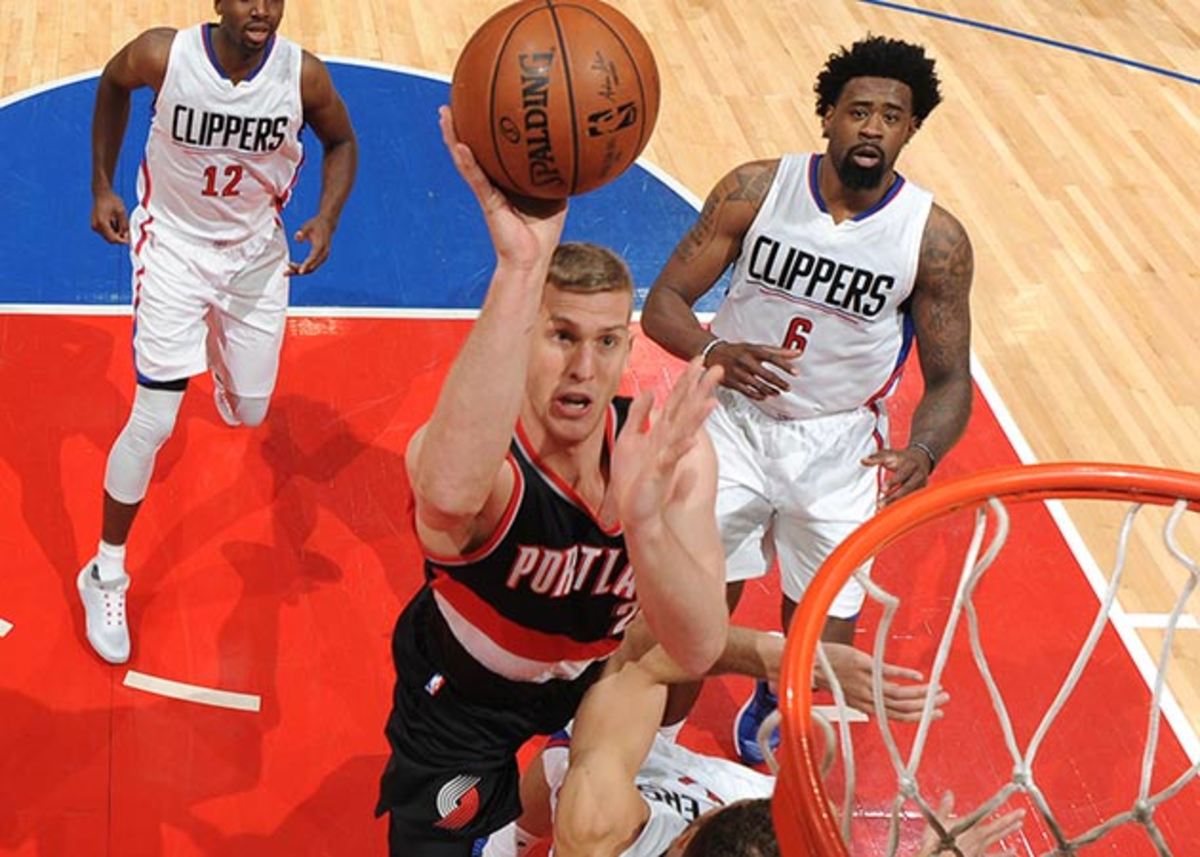Mason Plumlee emerges as unlikely playmaker for surging Blazers

Get all of Rob Mahoney's columns as soon as they’re published. Download the new Sports Illustrated app (iOS or Android) and personalize your experience by following your favorite teams and SI writers.
Every rookie to set foot on an NBA court carries a defined role. Some are drafted to be shooters or rebounders, playmakers or defenders. The intentions for their careers are set in the moment they ink their first contract—a binding agreement stipulating that an NBA team sees them fit for some particular purpose.
This structure can be empowering to some. For others, that kind of early definition imposes artificial limits. NBA players quickly become known for what they do well and can only do well what they’re allowed to do at all. Take Mason Plumlee, who for two years served as Brooklyn’s resident roll man. The Nets saw Plumlee as an endpoint. His hands were good enough to catch a lob and his legs springy enough for him to finish consistently. Playing time came by applying those traits in a very specific, low-maintenance way. It wasn’t until he came to Portland this season that we found out Plumlee had been an ace playmaker all along—a fact then unknown even to Blazers coach Terry Stotts.
“We noticed it early when we got him when he was here in September working out—his playmaking ability, how he could handle the ball for a big man, his passing,” Stotts said in an interview with SI.com back in January. “He enjoyed that part of it. I thought—I think we all thought—that when we saw that in September, that it was something that he really hasn't explored to see what he was capable of doing.”
• MORE NBA: Why Spurs vs. Thunder will be nothing short of spectacular

Portland’s season was dedicated in part to exploring those possibilities. Al-Farouq Aminu took as many three-pointers as Spurs sharpshooter Danny Green. C.J. McCollum was entrusted to create. Allen Crabbe ran curls as a primary option rather than waiting for kick-outs in the corner. Plumlee was allowed enough reps as a playmaker that when Portland’s offense bogged down in Game 1 against the Clippers, Plumlee became the first wave of strategic response. The backdoor swung wide open:
“I think Plumlee's a guy who's good at reading,” McCollum told SI.com in January. “We do a lot of back screens and slips and stuff like that. He's good at making that backdoor pass.”
The most effective way to combat the trap, though, is to circumvent it entirely. At first that might seem impossible; Lillard and McCollum are Portland’s best shot creators, and the pick-and-roll is central to the way they generate offense. Stotts was able to tweak that balance beginning in Game 2 to feature fewer straight pick-and-rolls and more varied possessions for both Lillard and McCollum. There aren’t many NBA teams that could afford to take the ball out of the hands of their two best ball handlers (who double as the team’s two highest-usage scorers) mid-series and adjust course so smoothly. Portland is exceptional because Plumlee is, too—a rare big who, for stretches of this series, has effectively ran point:
“I knew [Plumlee] was a really good athlete,” Lillard told SI.com in January. “I knew he was a big guy. But he can really pass the ball, handle the ball. He can rebound and push it and I can go run the perimeter and he can go find me for an open shot. He's really a team-first guy—he plays hard and doesn't back down. There's a lot things that Mase does and brings to the table that I didn't know of. That really caught me by surprise.”
• MORE NBA: Winners and losers from wild start to the NBA playoffs
Then, on those occasions when the Blazers did run pick-and-roll (or dribble hand-offs that simulated the same action), Plumlee put on his Draymond Green hat and began making plays from the short roll:
Some of these possessions were back-breakers for the Clipper defense. Portland’s choice to operate through Plumlee didn’t just defuse the trap. It served to weaponize two non-shooters (Plumlee and Maurice Harkless) whom L.A. had thought it safe to disregard in its tailored defense for the series. Plumlee’s playmaking emergence in Games 2 and 3 brought doubt to that premise. So much of playoff basketball lives in the tension between process and result. When those two are aligned (as was the case in Game 1), you see the Clippers fully invested in a specific plan of disruption. Plumlee’s operations suggested a weakness within it. Every baseline finish from Harkless made that weakness real and immediate in the thick of a competitive game.
Conceptually, this should change nothing. Realistically, it takes incredible focus for a defense to execute a game plan with full energy and commitment knowing that it will likely be exploited. Even the slightest delay could create big problems for a team that willingly puts itself into rotation on every pick-and-roll possession. Plumlee helped to create some of that—first by rolling in a way that drew attention to himself, then by setting up Harkless and Aminu for open looks, and now by adding some ambiguity into how Clippers players think they should go about each defensive possession.
Playoff series are won on that kind of strategic turn. As recently as a year ago this entire development would have seemed absurd; though productive for Brooklyn overall, Plumlee never registered more than three assists in any game for the Nets last season. The broadening of his role in Portland has allowed Plumlee to triple his per-game assist numbers. In the playoffs, he's vaulted to 7.4 assists per 36 minutes—the seventh-highest figure of any player. The rolls and rebounds (Plumlee has totaled 65 through five games) are still there. What’s absent is the sharp definition restricting all that Plumlee could possibly be.
